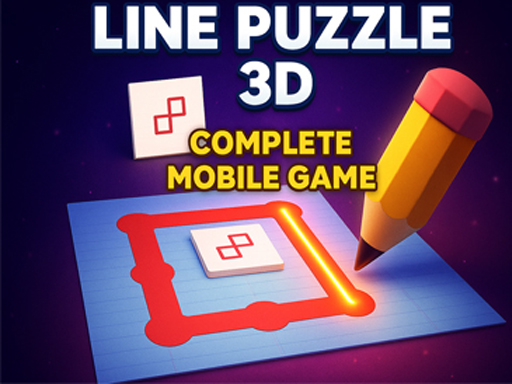Clone Architect: Stack Logic
About Clone Architect: Stack Logic
Okay, so listen, I’ve stumbled onto something truly special, and I’ve been absolutely buzzing about it. You know how sometimes you pick up a game, and it just *clicks*? Like, from the very first moment, you feel that spark, that little voice in your head going, "Oh, this is going to be good"? That’s exactly what happened with *Clone Architect: Stack Logic*. I mean, honestly, I haven't been this genuinely excited to talk about a puzzle-platformer in ages.
I’ve always been drawn to games that take a super simple concept and just twist it into something incredibly clever, something that makes you feel like a genius when you finally crack a tough level. And *Clone Architect*? It does that in spades. It’s a 2D pixel-art game, right? And when I first saw the screenshots, I thought, "Okay, cute, another retro-inspired platformer." But then I started playing, and holy smokes, it just opens up this whole new dimension of thinking.
The core idea is deceptively simple: you're this little character, and for some unknown, wonderfully convenient reason, you have the power to create clones of yourself. But not just any clones – these aren't some AI companions or anything. These are *physical manifestations* of you that you can then *stack*. And that, my friend, is where the magic happens.
Imagine this: you're in a level, and there's a ridiculously high ledge you need to reach, or a deadly pit of spikes that’s just a little too wide to jump. Your first instinct, like any seasoned platformer player, is to look for a hidden spring, a moving platform, or some environmental object to manipulate. But then you remember: *you* are the object. You hit a button, and *poof*, a clone appears right where you’re standing. You jump on its head, hit the button again, and *poof*, another clone appears on *its* head. Suddenly, you’re building a makeshift staircase out of yourself. It’s absurd, it’s brilliant, and it feels incredibly intuitive once you get the hang of it.
What I love about games like this is how they force you to rethink basic assumptions. You’re not just jumping *over* obstacles; you’re literally *building* your way through them. The level design in *Clone Architect* is just phenomenal because it constantly pushes the boundaries of what you think is possible with this one core mechanic. You'll find yourself staring at a screen, completely stumped, maybe even a little frustrated, thinking, "There's no way to get across that gap," or "How am I ever going to reach that tiny little exit door way up there?" And then, usually after a few failed attempts and a lot of head-scratching, it just *clicks*.
That "click" moment, man, that’s the gold standard for me in puzzle games. It’s when your brain suddenly reconfigures itself, and you see the solution not as a series of individual actions, but as a fluid, elegant sequence of clone placements. You realize you don’t just need one clone, or two, but maybe three, stacked in a very specific way, with the top one positioned just so that you can leap off its head, clear the spikes, and land perfectly on the other side. Or maybe you need to create a clone, jump on it, create *another* clone while mid-air, so it appears *above* the first one, forming a bridge that wasn’t there a second ago. It’s like playing Tetris with your own body, but in real-time, under pressure.
The visual style, being pixel art, really helps keep the focus on the mechanics. There aren't a lot of distractions. It's clean, it's crisp, and the animations are surprisingly expressive for such tiny sprites. You can almost feel the weight of your character as you jump, the slight bounce when you land on a clone's head. And the sound design, while minimalistic, perfectly punctuates each action – the satisfying little *thwip* when a clone appears, the soft *thud* when you land. It all contributes to this incredibly focused, almost meditative gameplay loop.
The brilliant thing about this is that the game doesn't just rely on simple height and distance puzzles. Oh no, it gets way more intricate. You'll encounter moving platforms that require you to time your clone creation perfectly, so your stack moves with the platform. There are pressure plates that need to be held down, and suddenly, one of your precious clones becomes a permanent fixture, sacrificing itself for the greater good of the level. And let me tell you, having to decide which clone to "sacrifice" and which to use for your final ascent adds a layer of strategic depth that I honestly wasn't expecting. It's not just about reaching the goal; it's about resource management – and your clones *are* your resources.
In my experience, the best moments come when you're forced to perform a complex sequence of actions under a tight time limit, or when you have to build a precarious tower of clones, knowing that one wrong move, one misplaced jump, will send your entire carefully constructed edifice tumbling down. Your heart rate genuinely picks up in those moments. You can almost feel the tension in your shoulders as you meticulously position each clone, your eyes darting between your character, the stack, and the distant exit door. And then, when you finally pull it off, when you execute that perfect, multi-clone, mid-air, pixel-perfect jump to the exit, the rush of satisfaction is just immense. It’s not just a victory; it’s a personal triumph over a challenge you thought was impossible.
What's fascinating is how the game introduces new elements so gradually that you barely notice the difficulty ramping up until you're tackling puzzles that would have seemed utterly bewildering just a few hours ago. It’s a masterclass in progressive difficulty. You start with simple "reach the high platform" scenarios, then it's "cross the spike pit," then it's "hit the switch, cross the pit, and reach the exit, all while avoiding a moving laser." Each new mechanic, each new environmental hazard, forces you to innovate with your clone-stacking abilities.
There's something magical about how *Clone Architect* takes a concept that could easily be clunky or frustrating and makes it feel so fluid and empowering. It’s not about brute force or lightning-fast reflexes (though a little precision helps); it’s about observation, planning, and that wonderful moment of creative problem-solving. It’s the kind of game that makes you feel smarter for playing it. You'll find yourself sketching out solutions in your head, visualizing the exact trajectory of your jumps, the precise moment to summon a clone.
Honestly, I’ve lost track of time so many times playing this game. You just get into this flow state, where the outside world fades away, and it’s just you, your clones, and the puzzle in front of you. And then, when you finally clear a particularly tricky level, you sit back, take a deep breath, and maybe even let out a little "Yes!" under your breath. That feeling, that pure, unadulterated sense of accomplishment, is what keeps me coming back.
The real magic happens when you start experimenting, when you push the boundaries of what you *think* the game wants you to do. Sometimes, the most convoluted-looking solution is actually the most elegant. You might try building a tall tower, only to realize you need to build a short one, jump off, create a clone mid-air to extend your reach, and then land on a tiny ledge. It’s a constant dance between logic and improvisation.
This makes me wonder about the developers' thought process. How did they come up with so many variations on such a simple theme? Each level feels fresh, introducing a new wrinkle or demanding a slightly different approach. It never feels repetitive, which is a huge achievement for a puzzle game with a core mechanic this focused.
So yeah, if you're into games that make you think, that reward cleverness over brute force, and that give you that incredible "aha!" moment of satisfaction, then you absolutely, positively need to check out *Clone Architect: Stack Logic*. It’s a gem, a true discovery, and I genuinely believe it’s going to be one of those games that people talk about for its ingenious design for a long time. Go on, give it a shot. I promise you, you won't regret it. Just prepare to lose a few hours, because once you start stacking, it's hard to stop.
I’ve always been drawn to games that take a super simple concept and just twist it into something incredibly clever, something that makes you feel like a genius when you finally crack a tough level. And *Clone Architect*? It does that in spades. It’s a 2D pixel-art game, right? And when I first saw the screenshots, I thought, "Okay, cute, another retro-inspired platformer." But then I started playing, and holy smokes, it just opens up this whole new dimension of thinking.
The core idea is deceptively simple: you're this little character, and for some unknown, wonderfully convenient reason, you have the power to create clones of yourself. But not just any clones – these aren't some AI companions or anything. These are *physical manifestations* of you that you can then *stack*. And that, my friend, is where the magic happens.
Imagine this: you're in a level, and there's a ridiculously high ledge you need to reach, or a deadly pit of spikes that’s just a little too wide to jump. Your first instinct, like any seasoned platformer player, is to look for a hidden spring, a moving platform, or some environmental object to manipulate. But then you remember: *you* are the object. You hit a button, and *poof*, a clone appears right where you’re standing. You jump on its head, hit the button again, and *poof*, another clone appears on *its* head. Suddenly, you’re building a makeshift staircase out of yourself. It’s absurd, it’s brilliant, and it feels incredibly intuitive once you get the hang of it.
What I love about games like this is how they force you to rethink basic assumptions. You’re not just jumping *over* obstacles; you’re literally *building* your way through them. The level design in *Clone Architect* is just phenomenal because it constantly pushes the boundaries of what you think is possible with this one core mechanic. You'll find yourself staring at a screen, completely stumped, maybe even a little frustrated, thinking, "There's no way to get across that gap," or "How am I ever going to reach that tiny little exit door way up there?" And then, usually after a few failed attempts and a lot of head-scratching, it just *clicks*.
That "click" moment, man, that’s the gold standard for me in puzzle games. It’s when your brain suddenly reconfigures itself, and you see the solution not as a series of individual actions, but as a fluid, elegant sequence of clone placements. You realize you don’t just need one clone, or two, but maybe three, stacked in a very specific way, with the top one positioned just so that you can leap off its head, clear the spikes, and land perfectly on the other side. Or maybe you need to create a clone, jump on it, create *another* clone while mid-air, so it appears *above* the first one, forming a bridge that wasn’t there a second ago. It’s like playing Tetris with your own body, but in real-time, under pressure.
The visual style, being pixel art, really helps keep the focus on the mechanics. There aren't a lot of distractions. It's clean, it's crisp, and the animations are surprisingly expressive for such tiny sprites. You can almost feel the weight of your character as you jump, the slight bounce when you land on a clone's head. And the sound design, while minimalistic, perfectly punctuates each action – the satisfying little *thwip* when a clone appears, the soft *thud* when you land. It all contributes to this incredibly focused, almost meditative gameplay loop.
The brilliant thing about this is that the game doesn't just rely on simple height and distance puzzles. Oh no, it gets way more intricate. You'll encounter moving platforms that require you to time your clone creation perfectly, so your stack moves with the platform. There are pressure plates that need to be held down, and suddenly, one of your precious clones becomes a permanent fixture, sacrificing itself for the greater good of the level. And let me tell you, having to decide which clone to "sacrifice" and which to use for your final ascent adds a layer of strategic depth that I honestly wasn't expecting. It's not just about reaching the goal; it's about resource management – and your clones *are* your resources.
In my experience, the best moments come when you're forced to perform a complex sequence of actions under a tight time limit, or when you have to build a precarious tower of clones, knowing that one wrong move, one misplaced jump, will send your entire carefully constructed edifice tumbling down. Your heart rate genuinely picks up in those moments. You can almost feel the tension in your shoulders as you meticulously position each clone, your eyes darting between your character, the stack, and the distant exit door. And then, when you finally pull it off, when you execute that perfect, multi-clone, mid-air, pixel-perfect jump to the exit, the rush of satisfaction is just immense. It’s not just a victory; it’s a personal triumph over a challenge you thought was impossible.
What's fascinating is how the game introduces new elements so gradually that you barely notice the difficulty ramping up until you're tackling puzzles that would have seemed utterly bewildering just a few hours ago. It’s a masterclass in progressive difficulty. You start with simple "reach the high platform" scenarios, then it's "cross the spike pit," then it's "hit the switch, cross the pit, and reach the exit, all while avoiding a moving laser." Each new mechanic, each new environmental hazard, forces you to innovate with your clone-stacking abilities.
There's something magical about how *Clone Architect* takes a concept that could easily be clunky or frustrating and makes it feel so fluid and empowering. It’s not about brute force or lightning-fast reflexes (though a little precision helps); it’s about observation, planning, and that wonderful moment of creative problem-solving. It’s the kind of game that makes you feel smarter for playing it. You'll find yourself sketching out solutions in your head, visualizing the exact trajectory of your jumps, the precise moment to summon a clone.
Honestly, I’ve lost track of time so many times playing this game. You just get into this flow state, where the outside world fades away, and it’s just you, your clones, and the puzzle in front of you. And then, when you finally clear a particularly tricky level, you sit back, take a deep breath, and maybe even let out a little "Yes!" under your breath. That feeling, that pure, unadulterated sense of accomplishment, is what keeps me coming back.
The real magic happens when you start experimenting, when you push the boundaries of what you *think* the game wants you to do. Sometimes, the most convoluted-looking solution is actually the most elegant. You might try building a tall tower, only to realize you need to build a short one, jump off, create a clone mid-air to extend your reach, and then land on a tiny ledge. It’s a constant dance between logic and improvisation.
This makes me wonder about the developers' thought process. How did they come up with so many variations on such a simple theme? Each level feels fresh, introducing a new wrinkle or demanding a slightly different approach. It never feels repetitive, which is a huge achievement for a puzzle game with a core mechanic this focused.
So yeah, if you're into games that make you think, that reward cleverness over brute force, and that give you that incredible "aha!" moment of satisfaction, then you absolutely, positively need to check out *Clone Architect: Stack Logic*. It’s a gem, a true discovery, and I genuinely believe it’s going to be one of those games that people talk about for its ingenious design for a long time. Go on, give it a shot. I promise you, you won't regret it. Just prepare to lose a few hours, because once you start stacking, it's hard to stop.
Enjoy playing Clone Architect: Stack Logic online for free on Qotori games. This Puzzle game offers amazing gameplay and stunning graphics. No downloads required, play directly in your browser!
How to Play
- Move A D or larr rarr - Jump W uarr or Spacebar - Create Clone F Restart Level R Return to Menu P





Comments
This game is awesome! I love the graphics and gameplay.
One of the best games I've played recently. Highly recommended!